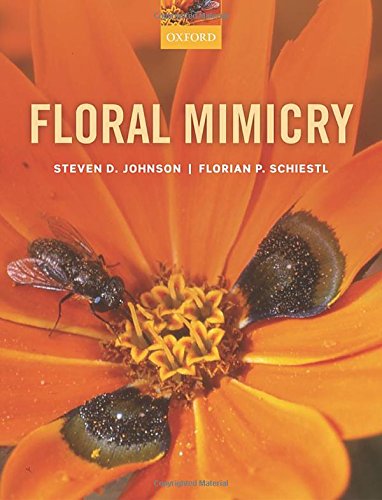Floral mimicry 1st Edition by Steven D Johnson, Florian P Schiestl ISBN 0191047244 9780191047244
$50.00 Original price was: $50.00.$25.00Current price is: $25.00.
Floral mimicry 1st Edition by Steven D Johnson, Florian P Schiestl – Ebook PDF Instant Download/Delivery: 0191047244, 9780191047244
Full download Floral mimicry 1st Edition after payment

Product details:
ISBN 10: 0191047244
ISBN 13: 9780191047244
Author: Steven D Johnson, Florian P Schiestl
Mimicry is a classic example of adaptation through natural selection. The traditional focus of mimicry research has been on defence in animals, but there is now also a highly-developed and rapidly-growing body of research on floral mimicry in plants. This has coincided with a revolution in genomic tools, making it possible to explore which genetic and developmental processes underlie the sometimes astonishing changes that give rise to floral mimicry. Being literally rooted to one spot, plants have to cajole animals into acting as couriers for their pollen. Floral mimicry encompasses a set of evolutionary strategies whereby plants imitate the food sources, oviposition sites, or mating partners of animals in order to exploit them as pollinators. This first definitive book on floral mimicry discusses the functions of visual, olfactory, and tactile signals, integrating them into a broader theory of organismal mimicry that will help guide future research in the field. It addresses the fundamental question of whether the evolutionary and ecological principles that were developed for protective mimicry in animals can also be applied to floral mimicry in plants. The book also deals with the functions of floral rewardlessness, a condition which often serves as a precursor to the evolution of mimicry in plant lineages. The authors pay particular attention to the increasing body of research on chemical cues: their molecular basis, their role in cognitive misclassification of flowers by pollinators, and their implications for plant speciation. Comprehensive in scope and conceptual in focus, Floral Mimicry is primarily aimed at senior undergraduates, graduate students, and researchers in plant science and evolutionary biology.
Floral mimicry 1st Table of contents:
1. Introduction
What is mimicry?
The scope of floral mimicry
The discovery of floral mimicry
Key concepts
Adaptive resemblance
Cognitive misclassification
Advergent evolution
Honest signals and reliable cues
Imperfect mimicry
Accurate mimicry
Frequency dependence
Predictions for mimicry systems
The semantics of floral mimicry
Exploitation of receiver bias
Mimicry versus deception
Modalities of signaling
Niches and ecological specialization
The structure of this book
2. The evolution and maintenance of floral rewardlessness
Introduction
Darwin’s “gigantic imposture”
The prevalence of rewardlessness among plants
Phylogenetic evidence for transitions between reward and deception
The evolution of empty flowers: cost-based models
The costs of nectar
Can pollinators remotely detect empty flowers in a rewarding species?
Nectar-deployment models based on mating patterns
Supplementation of nectar in rewarding flowers
What can we learn from studies of nectar robbing?
The puzzle of floral deception in orchids
The pollen transport efficiency hypothesis
The cross-pollination hypothesis
The genetic load paradox
Deception and diversification
Overview and perspectives
3. Generalized food deception
Introduction
Generalized food deception and floral mimicry
The role of learning
Innate preferences
Avoidance learning
Deception of nectar- versus pollen-seeking animals
Selection for showy floral displays
Flower polymorphism and negative frequency-dependent selection
The early flowering hypothesis
Effects of population size and plant density
Remote habitats versus the magnet species effect
Pollination system generalization and hybridization
Overview and perspectives
4. Batesian food-source mimicry
Introduction
Theoretical criteria and predictions
Phenology and pollinator sharing
Advergence and function of floral signals
Flower color
Complex color patterns
Flower shape and inflorescence architecture
Floral scent
Pollinator discrimination between mimics and models
Evidence that mimics benefit from the presence of models
Frequency dependence
The geography of Batesian food-source mimicry
Nested distributions
Trait tracking
Geographic polymorphism
Taxonomic bias in the pollinators of food-source mimics
Guild mimicry
Overview and perspectives
5. Sexual mimicry
Introduction
Phylogenetic distribution of sexual mimics and their pollinators
Signal evolution
The importance of olfactory signals
Visual signals
Tactile stimuli
Receiver bias
Pollinator shifts and speciation in sexual mimics
The species problem
Why are species of sexual mimics so similar genetically?
Speciation
Which traits mediate floral isolation?
The possibility of speciation with gene flow
The evolution of sexual mimicry
Future directions
6. Oviposition-site mimicry
Introduction
Key features of oviposition-site mimicry
Geoflory
Traps and chambers
Thermogenesis
Floral gigantism
Carrion mimicry
The importance of oligosulfides
Visual and tactile imitation of carrion
Are there specialized niches for carrion mimicry?
Fecal mimicry
Fermenting fruit mimicry
Mushroom mimicry
Aphid mimicry
Oviposition-site mimicry in fungi and mosses
Oviposition-site mimicry and diversification of plant lineages
Overview and perspectives
7. Special cases
Introduction
Intersexual resemblance
Resemblance among rewarding flowers
Fungal pseudoflowers
Endophytic fungi, floral signals, and insects
Are pseudoflowers Müllerian mimics of real flowers?
Adaptive value of similarity
Fungal pollen mimicry
Mimicry of insect brood provisions
Male-biased pollinator assemblages
Overview and perspectives
8. Future directions in floral mimicry research
Introduction
Mimicry and speciation
Mimicry and phenotypic divergence
Improving our understanding of floral signals
Genetic bases of traits important for mimicry
Molecular genetics of floral mimicry
Genome sequencing
Special tools for functional molecular investigations
Mechanisms of evolution in mimicry
The genetic architecture of mimicry
What are the origins and evolutionary patterns of mimicry genes?
Convergent evolution at the molecular level
Developmental biology in floral mimicry
People also search for Floral mimicry 1st:
Tags:
Steven D Johnson,Florian P Schiestl,Floral,mimicry
You may also like…
Biology and other natural sciences - Molecular
Euglena Biochemistry Cell and Molecular Biology 1st Edition Steven D. Schwartzbach
Medicine
Education Studies & Teaching - School Education & Teaching
Career Development and Counseling Putting Theory and Research to Work 3rd Edition Steven D. Brown
Science (General)
Cellular Therapies for Retinal Disease A Strategic Approach 1st Edition Steven D. Schwartz
Politics & Philosophy - Others
Earth Sciences - The Environment
Politics & Philosophy
Reference - Encyclopaedias











